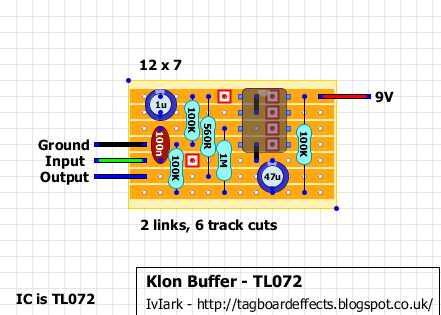Re: adding a feedback control to a Shin Ei Fuzz Companion
Posted: Sat Apr 30, 2016 11:15 pm
moid wrote:I decided to record some samples and plugged it into other pedals, whereupon the feedback knob no longer does anything, except at maximum when it cuts all noise out and passes clean guitar instead... I checked this wasn't a power issues by using different plugs / power sources for the other pedals, so I don't think it's a ground issue (or maybe it is?)... once more any thoughts on how I can get this to now play nicely with its new pedal friends? Thankyou and please don't feel obliged to reply - the pedal is still awesome on its own, but part of me wants to run weird sounds into it to see how it messes them up
So, if I am reading this correctly: the pedal, when operated by itself, still works. True?
Few questions:
When you are playing the pedal by itself, and it is working, what exactly is your signal path? I know, I know = guitar or bass into pedal into amp - name names, or better yet, break out the multimeter and measure stuff like DC resistance on the amp input, DC resistance on the instrument output. Keep notes - I don't need to know this shit..
Now, when you add pedals, presumably starting with one: what changes? Again, you want to draw a road map of input/output characters and observe the changes in relation to the measurements.
It might behoove you to build a unity gain buffer or two to "isolate" the effect to a degree. But ultimately, this is a matter of test & observation.
Here are my thoughts: it is possible the feedback path, while it operates in a satisfactory manner locally (in the three piece straight line set-up), may react in a completely different manner when exposed to other active stages, be it the output of an effect or a different type of input load (I have observed, at times, startling performance changes when I take an experimental circuit off my bench (the bench amp has a MOSFET input and is really high impedance) and plugged into an old tube amp that reflects a 100K load.
So, think about where the feedback path is, and consider this might be a situation made for an onboard buffer (TL072 style). I say might, it's hard to say. I have some stuff that will essentially do a filter sweep as I roll down my guitar volume due to the tuned circuit of inductor (pup) + cap (input DC blocker) + resistor (volume control) that a buffer would kill. This is why I mention an external buffer you can move around and play with before committing to the change.
Also, EYG poses a really good point in that it would be a good idea to replicate the circuit, taking care with assembly. That way you have a spare, or something to sling and a whole 'nother round of the best education.
